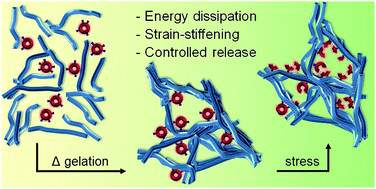Virus-like particles as crosslinkers in fibrous biomimetic hydrogels: approaches towards capsid rupture and gel repair†
Abstract
Biological hydrogels can become many times stiffer under deformation. This unique ability has only recently been realised in fully synthetic gels. Typically, these networks are composed of semi-flexible polymers and bundles and show such large mechanical responses at very small strains, which makes them particularly suitable for application as strain-responsive materials. In this work, we introduced strain-responsiveness by crosslinking the architecture with a multi-functional virus-like particle. At high stresses, we find that the virus particles disintegrate, which creates an (irreversible) mechanical energy dissipation pathway, analogous to the high stress response of fibrin networks. A cooling–heating cycle allows for re-crosslinking at the damaged site, which gives rise to much stronger hydrogels. Virus particles and capsids are promising drug delivery vehicles and our approach offers an effective strategy to trigger the release mechanically without compromising the mechanical integrity of the host material.



 Please wait while we load your content...
Please wait while we load your content...